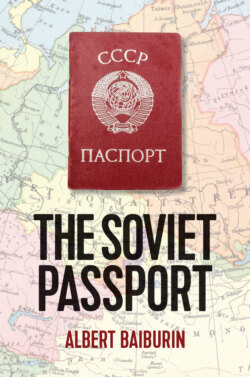Читать книгу The Soviet Passport - Albert Baiburin - Страница 23
8.
ОглавлениеIn examining the Soviet passport I start from the supposition that the way in which the passport system functioned was governed not just by official rules. Of no less importance is the way in which these rules were understood and assimilated and how they were strengthened. Furthermore, different groups and associations developed particular ways to interpret official demands. Such an approach is based on certain specifics of the way the law operated in the USSR. In the Soviet period it was typical for two parts of the official law to exist side-by-side. One part contained, conventionally speaking, decrees and resolutions that were public and available for all to see; the other was hidden, containing information by way of all sorts of instructions, orders and directives, stamped with notices such as ‘Not for publication’, ‘Not to be made public’, ‘Secret’, ‘Eyes only’ and so on. Naturally, the most significant ones were those hidden resolutions in which state bodies were instructed how to interpret an order or how to put it into practice.58 The hidden part included documents that were directly related to a citizen’s obligations. The citizen, however, may have been totally unaware of the existence of these documents; nevertheless, he or she was expected to carry out the instructions contained therein.
In this information drought, another, unofficial, legal system sprang up. This came about because of the way in which Soviet citizens reacted to the demands that were being forced upon them to adapt to the new norms and models of behaviour. This second legal system (Legal System-2) developed through genuine and imagined dialogues with government officials at all levels. The hidden official law led to the creation of unofficial laws in situations where nothing was actually being demanded, but citizens guessed that some sort of official rules or norms existed. In such cases, as I shall try to show, the unofficial law was not complete or uniform for the whole population. It contained variations, which were worked out by particular groups (such as limitchiki or former spetsposelentsy).59
As a result of this, the passport system to some extent contained elements of these two laws in the way in which it functioned.
If we look at the passport as a document, we can see in it the bureaucratic version of the person (‘the documented “I”’), thanks to which the person is given the right to exist in the eyes of the state. In many ways it was only thanks to the passport that the person became a member of society. At first glance, there was no alternative to this transformation: everyone was pressed into the same mould; however, within the framework of this mould there were gaps that were filled in by the unofficial law.
The fundamental question that I have tried to answer is, how did the Soviet passport system operate in both its official and its unofficial variations (Legal System-1 and Legal System-2)? The way in which the prescribed identity was created and spread by the authorities will be emphasized; and also how it was accepted, assimilated and ‘corrected’ by the Soviet people. Such an approach to trying to understand the Soviet passport and the passport system, it seems to me, demands the investigation of a few more precise questions:
1 How did the tradition come about in the pre-Soviet period of describing the person (the ‘passport portrait’)?
2 What did the official Soviet ‘passport person’ look like (Legal System-1)?
3 How did Soviet citizens relate to their official image and the rules of the passport system, and how did they adapt it to suit themselves (Legal System-2)?
The three parts of this book are devoted to investigating these questions. To answer the first question, one has to examine the social history of the passport in pre-revolutionary Russia and in the Soviet Union, emphasizing how the institutions of power developed the passport portrait. It is important to note that the functioning of the passport is not the same as the establishment and maintenance of control, and at different times the passport system had different meanings. These issues will all be considered in the first part of this work.
The second part is devoted to the official bureaucratic view of the passport as a document, examining its contents: its designations, its properties and its design. Here I discuss the passport as a document: how it was created and improved according to the model for identification that was applied to make the official image of the Soviet person. This has never been examined previously; but it is essential to explain the evolution of the ideas of the official ‘authors’ of this document as to how they perceived the Soviet ‘passport person’.
Finally, in the third part I look at the role that citizens themselves played in forming the passport rules. Using reminiscences, interviews and witness testimonies, I examine a number of ways in which the passport rules (the official methods for identification) were mastered, used and transformed into what they eventually became. To do this I looked at the unofficial norms and rules that were linked to the passport, its use in a variety of situations and the reinterpretation of its functions (Legal System-2).
It should be said that this book gives only the most general picture of the Soviet passport system; indeed, not even a picture but merely a few sketches of it. A great deal is missing that would be needed for a complete description of the subject. Virtually no attention is paid to how passports were issued on the ground, notably in the so-called ethnic outposts. Different periods of the history of the Soviet passport are examined in varying levels of detail. The ways in which the passport was used are much more varied than I have described here. In reality, this book is no more than an outline of the subject of ‘the Soviet passport’.
